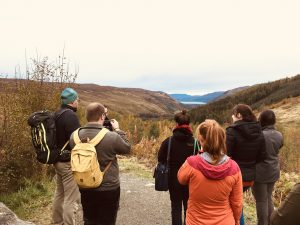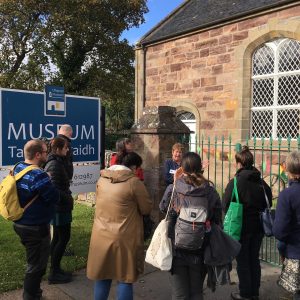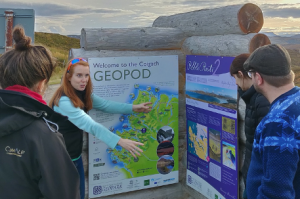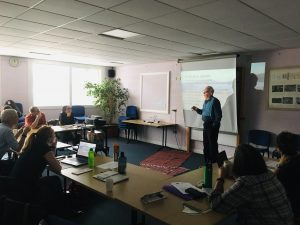Experiencing Developing a Community-led Destination Management Plan (DMP) in Wester Ross

At the beginning of the SHAPE project there was almost no collaboration for tourism in Wester Ross among public and private sector. Management for tourism was reactive and the host community had extreme views of visitors. Through discussion, networking and research we have established a will to cooperate between stakeholders, building capacity for the region through smarter use of resources and through training local information providers / ambassadors.
Destination Management is the process of coordinating and supporting the management of the aspects of a destination which contribute to a visitor’s experience, taking account of the needs of visitors, local residents, businesses and the environment to ensure future sustainability.
Aims of the learning journey
- To explain the step-by step process we enacted to develop a Destination Management Plan including the governance structures of the Biosphere and DMP Steering Group
- To inform stakeholders of the challenges faced through the DMP development process and how these were met
- To reflect on challenges which have not been adequately met both in Wester Ross and other SHAs and elicit group discussion and sharing of ideas.
Activities
Our learning journey, from 12-14 October, was organised in such a way to demonstrate both theoretical and practical experiences. Each morning there were workshops in order to learn about the DMP process and in the afternoon, participants experienced first-hand some of our cultural and natural heritage;
* Tour of Corrieshalloch Gorge National Nature Reserve by a Ranger for The National Trust for Scotland
* A visit to the gateway community of Garve to learn about early transport connections
* Historical guided tour of Ullapool, by the Ullapool Museum
* Guided visit to Stac Pollaidh, Knockan Crag National Nature Reserve and the Pebble route, by the Northwest Highlands Global Geopark Coordinator

Exploring joint solutions to common challenges
1) Lack of cooperation between stakeholders: Wester Ross has one of the lowest population densities in Europe: Our area covers over 5000 km2, but has only 8000 full time residents (1.6 people per km2). Our main tourism season runs from April – October each year, and we receive over 400k visitors.The terrain is particularly challenging – it’s quite mountainous with most of the villages located along the coast. This mountainous land contributes to lack of infrastructure, so it is not easy to travel around the area and so stakeholders tend to concentrate on their immediate localities.
SOLUTION: Collaboration by looking at the ‘big picture’
The visitor experience is not limited to the services they access such as food & drink, accommodation and attractions but is much more holistic. For example, the sense of place they may experience is controlled by the host community with whom they may interact, the quality of the environment and the ease of accessing attractions and sites of interest, either by using roads and car/bike parks or public transport. Visitors to an area may wish to access local services like swimming pools, toilets, leisure centres and health care. Finally, the provision of information and its communication is very important to a visitor’s experience of a region – visitors need to know where they can go and be welcome and where they will get the best experiences. They need to know what to do in an emergency, where to access the services they need and how to behave responsibly
2) Reactive Tourism Planning: Without a strategic approach which considers all aspects of the visitor experience, the impact on the environment, publicly owned assets and cultural heritage could eventually damage economic development and quality of life and so careful attention must be paid to understand these issues more thoroughly.

SOLUTION: Provide a framework and action plan for future tourism
Sustainable tourism must involve proactive planning and joint working. This strategic approach is known as a Destination Management Plan (DMP) which is written in collaboration with all of the different stakeholders (including the community & industry). It needs to contain agreed priorities, actions and resources for it to be meaningful, as well as measurable objectives to monitor and evaluate.
3) Limited statistics available to work with when planning for tourism development: There was no hard-empirical evidence on visitor numbers, expectations and behaviour or condition of assets in Wester Ross which would allow communities, businesses, local authorities and public agencies to plan proactively.

SOLUTION: Establish the baseline figures
The Destination Management Plan needs to be based on a sound knowledge and assessment of all the features of Wester Ross that relate to the visitor economy. For this reason, a series of baseline reports was produced in order to audit the tangible (i.e. natural heritage, built environment, access, services and facilities) and intangible cultural heritage to present to the wider stakeholders and communities before further defining the priority actions.
What our participants said
“It was interesting to meet the stakeholder involved in the process and understand how it was done. I will need to come back to see its impact.” – Kjartan, Iceland
“I like the idea of collaboration and am going to think how we can do more of it.” – Hjördís, Iceland
“I think it was very helpful, and I also think we learned that we have a lot of common problems and challenges, but hopefully also common strengths.” – Ørjan, Norway
“There were sufficient opportunities for free discussion alongside the programme of talks and field site visits that were very useful case studies for tourism management.” – Zoe, Scotland


